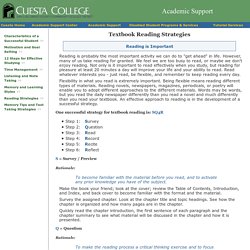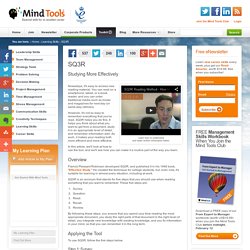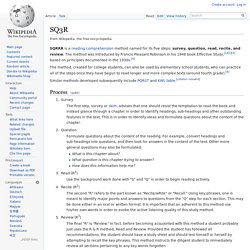

Textbook Reading Strategies. Reading is Important Reading is probably the most important activity we can do to "get ahead" in life.

However, many of us take reading for granted. We feel we are too busy to read, or maybe we don't enjoy reading. Not only is it important to read effectively when you study, but reading for pleasure at least 20 minutes a day will improve your life and your ability to read. Read whatever interests you - just read, be flexible, and remember to keep reading every day. Flexibility in what you read is extremely important. One successful strategy for textbook reading is: SQ4R Step 1: Survey Step 2: Question Step 3: Read Step 4: Record Step 5: Recite Step 6: Reflect S = Survey / Preview Rationale: To become familiar with the material before you read, and to activate any prior knowledge you have of the subject. SQ3R - Learning Skills from MindTools.com.
Studying More Effectively Learn how to understand and retain written information better.

Nowadays, it's easy to access new reading material. You can read on a smartphone, tablet, or e-book reader, and you can order traditional media such as books and magazines for next-day (or same-day) delivery. However, it's not so easy to remember everything that you've read. SQ3R helps you do this. In this article, we'll look at how to use the tool, and we'll see how you can make it a routine part of the way you learn. Overview Francis Pleasant Robinson developed SQ3R, and published it in his 1946 book, "Effective Study. " SQ3R is an acronym that stands for five steps that you should use when reading something that you want to remember. Survey.Question.Read.Recall.Review.
Applying the Tool To use SQ3R, follow the five steps below. Step 1: Survey Start by skimming through the material you've identified, to decide if it will be useful and to get an overview of the topic. Step 2: Question Step 3: Read. Textbook%20Reading%20Systems. Sq3r_method.doc. Active Reading of Textbooks - Active Reading of Textbooks - McGraw Center - Princeton University. The reading you do at Princeton differs in two significant ways from the reading you did in high school.

Not only are you asked to complete longer assignments in a shorter period of time, but you are also expected to analyze and evaluate what you read with more sophistication and skill. Professors expect you not just to comprehend what you read, but to be able to do something with it: talk or write about the material in an engaged and complex fashion, apply information or concepts to a new scenario or problem, or solve a problem you haven’t gone over in class, just to mention a few. The strategies listed below will help you to do a large quantity of reading without the tedium or frustration that sometimes results from having a lot to read. It will also help you to retain more of the key concepts and information that you will need to know for exams.
While this method is more applicable to textbook reading, you can modify it for reading literature or other more narrative type material. SQ3R. SQRRR is a reading comprehension method named for its five steps: survey, question, read, recite, and review.

The method was introduced by Francis Pleasant Robinson in his 1946 book Effective Study,[1][2][3] based on principles documented in the 1930s.[4] The method, created for college students, can also be used by elementary school students, who can practice all of the steps once they have begun to read longer and more complex texts (around fourth grade).[4] Process[edit] See also[edit] References[edit]